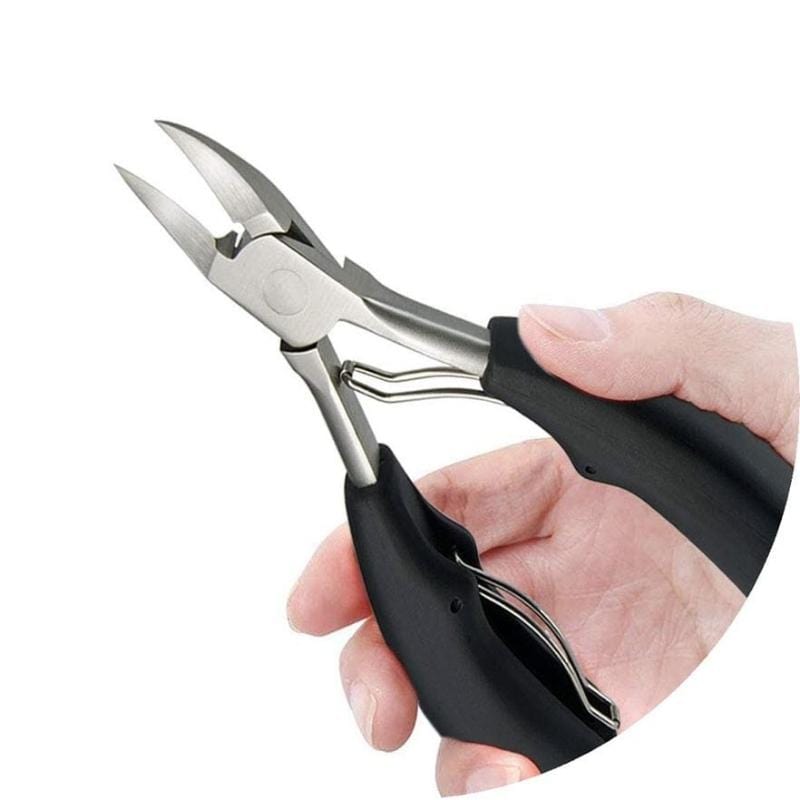Thick toenails (onychauxis) are common, especially as we get older. The general wear and tear over the years of leaving our nails too long, wearing the wrong shoes, stubbing and dropping things on our toes all cause a gradual (or sometimes rapid) thickening. There are also disease states that thicken nails, like psoriasis and fungal infections. But you don’t have to be old or have a medical condition to get thick toenails. This article discusses the problem of gnarly toenails from an active lifestyle perspective, how they can contribute to blisters (of course) and what you can do about it.
Thick Toenails and Nail Anatomy
This image shows the anatomy of a nail. The nail itself is called the nail plate (or body of nail in the image below). It is adhered to the skin of the nail bed. The bit you cut off that isn’t adhered to the nail bed is called the free edge. And the nail itself grows from a group of cells that lie further back under the skin called the nail matrix.
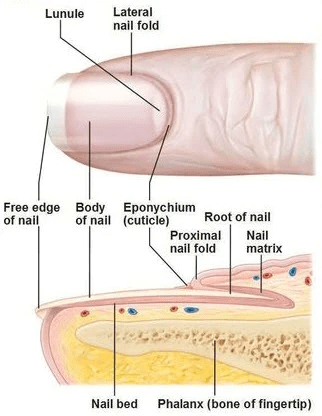
Nail anatomy (pinterest.com.au pin543176405049554095)
What Causes Thick Toenails?
In a word… trauma.
It only takes one episode of trauma to the right (or should I say wrong) part of your toe and you’ll be stuck with one thick toenail for life. But not every toenail trauma is going to result in permanent thickening - sometimes you can get lucky. Consider this…
- If you drop something really heavy on your nail plate (body of nail in the picture above), I’m pleased to say this probably won’t cause permanent thickening.
- Damage the free edge of the nail and that damage will simply grow out and you won’t get permanent nail thickening.
- But drop something on your toe where your nail matrix is – the cells where your nail is generated from - and you will get permanent nail thickening.
This makes sense when you think about it.
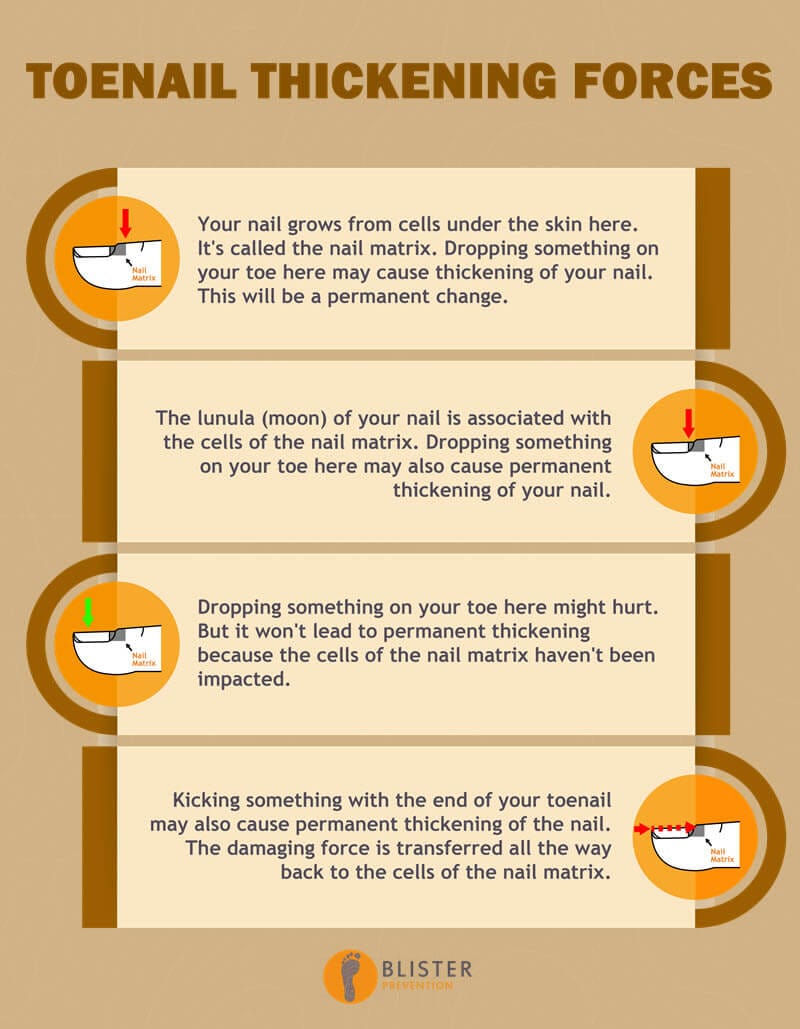
Toenail thickening forces
What About Stubbing Your Toe, I Hear You Say?
Absolutely! Stubbing your toe will cause thickening. That's in spite of the injury being imparted to the free edge – miles away from the matrix. The reality is, when you kick your toe, the whole nail plate moves backwards and all that force is inflicted on the cells of the nail matrix.
Common Nail-Thickening Scenarios
There are certain sports, leisure activities and occupations that often see thick toenails forming. Runners, hikers, netballers, squash players, ballet dancers, builders, mechanics and farmers frequently have one or more thick toenails. Ballet - think en pointe, and sports like netball, tennis and squash - think sudden decelerations. Sometimes it's a single trauma that causes the thickening; sometimes it slight but repetitive.
Single-Episode Painful Trauma Examples:
- Builders dropping heavy materials on their toes
- Cows, horses and sheep treading on farmers’ toes
- Footballers, netballers and basketball players having someone jump on their toes
Will They Thicken Straight Away?
Although these single big painful episodes of trauma will be very painful at the time, you won’t notice the thickening straight away. It takes 3-6 (sometimes a little longer) for a toenail to grow all the way from the matrix to become the free edge that you finally cut away when trimming your toenails.
Repetitive Microtrauma
So that’s single episodes of trauma. These episodes usually occur to one or two toes. But repetitive microtrauma can be just as damaging. And repetitive microtraumas often leads to more than one toenail, sometimes all the nails, becoming thickened.
Repetitive microtrauma refers to lots of little knocks and insults that are not necessarily painful at the time. In fact, they often go beneath our notice. But they’re repetitive, and that’s the problem. Here are a few examples:
Toes Hitting The End Of Your Shoe:
Wearing shoes that are too big or your laces are too loose will cause damage. As you run or walk, your foot slips forward and your toenails gently (or not so gently) hit into the end of the toebox. Tap, tap, tap…bang, bang, bang… The nail is getting pushed on from the tip and moving relative to the toe bone underneath (this is what causes toenail blisters, by the way) and it’s impacting back at the nail matrix, where the nail grows from. The nail matrix is copping these small but repetitive microtraumatic episodes and THIS is what causes the nail to thicken, ever so slightly, day after day.
You won’t notice the thickening to start with, but day after day, week after week, month after month and year after year, your toenail will slowly thicken. You’ll be trimming your nails and you’ll suddenly think “When did my toenails get so tough to cut?”
Hammertoes and Claw Toes:
When your toes bend over with these common toe deformities, the tip of the toe and toenail become weightbearing. But neither the tip of the toe, nor the toenail, are designed to bear weight. With every step you take, the nail is pushed back onto the cells of the nail matrix, gradually traumatising them. Bit by bit, the resultant nail will be thicker.
Poor Shoe-Fit Causing The Trauma:
Back in the day, people had little choice but to wear shoes that didn’t fit them. During and after WWII, you were lucky to own a pair of shoes. Kids usually wore hand-me-downs that were too big to start with, then as they grew, the shoe became too small, with the toes constantly pushing into the end of the toebox. The same could be said for the adults of the day – as shoes wore out, there were other needs that were prioritised over a new pair of shoes… like food!
And think about the labourers in those days. Boots back then offered far less protection to the toes, yet the jobs were far more manual. That’s to mention nothing of the fact that there simply wasn’t the range of shoes available for feet that weren’t an average size or shape. Today, we have stylish “orthopaedic” shoe stores with depth and width options. Even running shoes come in different widths and forgiving uppers. Back then, wide feet and toe deformities were crammed into whatever shoes they could get. And people walked a lot more too. These are the reasons why I see a lot of elderly folk with very thick toenails.
Are Thick Toenails Painful?
Thankfully, thick toenails are not usually painful. The biggest issue is simply cutting them. Thick long nails can be painful, of course. Thick tonails can become painful if the nail has other issues, too. Like being curved (involuted) and digging into your toe a bit (ingrown toenail). Or where the repetitive trauma to the nail of a hammertoe or cocked up (hyperextended) big toe is less ‘micro’ and more ‘macro’ and sustained. Consider running, jumping or walking long distances. Blisters will form more readily under thick and rough toenails. You might even lose the nail altogether.
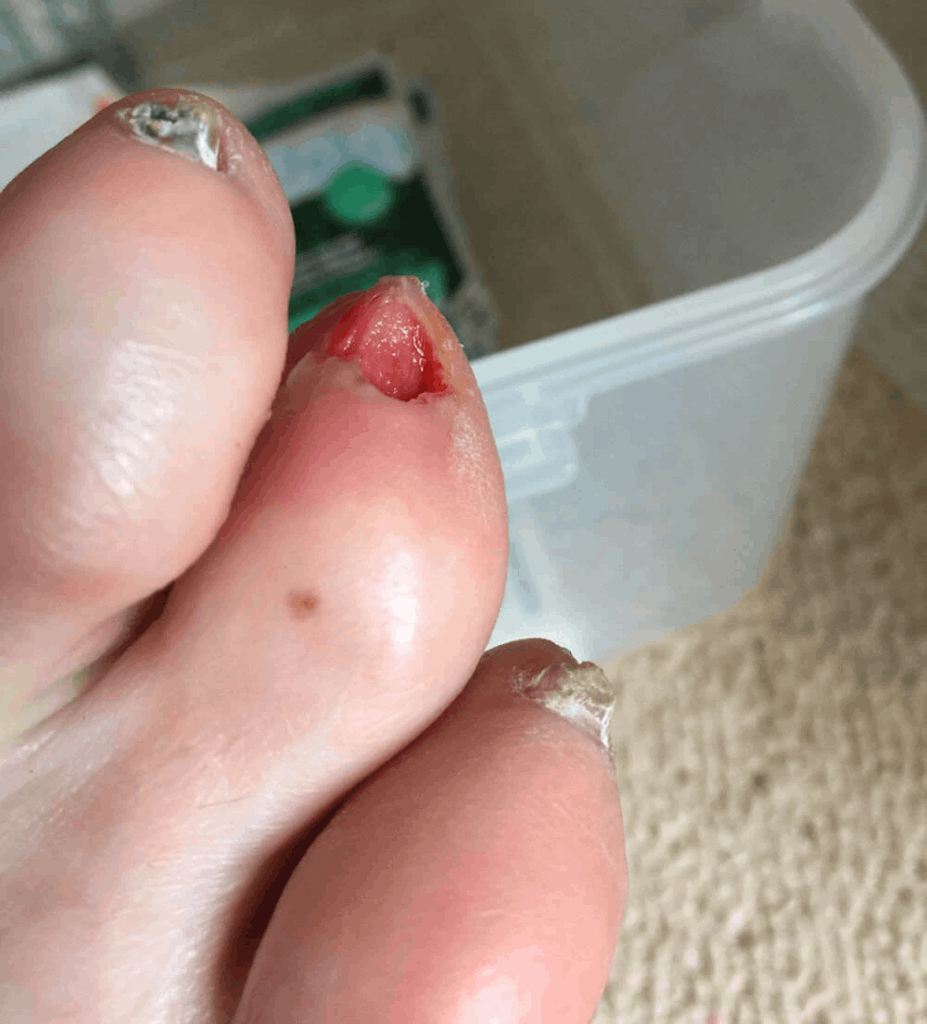
Thick toenails of a runner who suffered nail avulsion (toenail falling off).
Why Do Toenails Get Thicker As We Get Older?
The reason toenails tend to get thicker as we get older is simply because we’ve had longer to inflict injurious episodes on them – both the big painful episodes and the repetitive microtraumas. From stubbing them, dropping things on them, wearing the wrong shoes and people (or animals) standing on them, all of these things can cause gradual or sudden nail thickening. But your toenails don’t have to get thick with age. Don’t subject them to these traumas and you’ll have beautifully thin nails when you’re 100 years old.
Which Toenails Get Thickest?
Big toenails are often thick when the others aren’t either because this toe has been stubbed or injured badly. Or consider the alignment of the nail in this video. Imagine how, with the nail angled upwards and in a shoe with shallow toebox, the force that is imparted to the free edge which culminates in repetitive trauma to the nail matrix. Imagine running or walking downhill with the foot sliding forward in the shoe.
Little toe nails are very often thick when the others aren’t. Curly or twisted little toes are common and the nail is impacted more than it should be – from either the shoe or from sitting under the adjacent toe. That’s to mention nothing of its uncanny ability to find furniture when you haven’t turned the light on in the middle of the night on the way to the loo :)
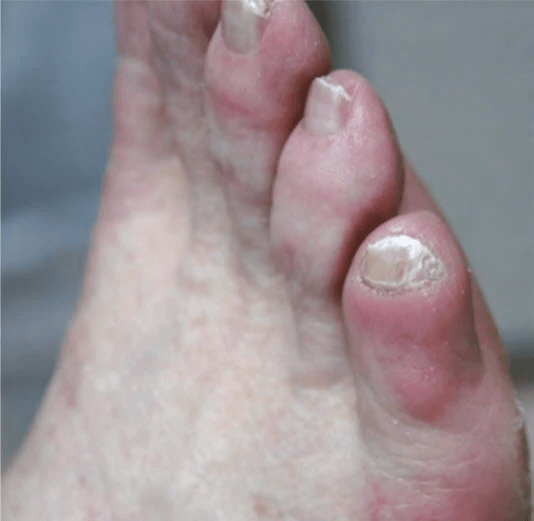
See how the toe is twisted such that the outer edge takes weightbearing pressure and pressure from the shoe upper. http://www.podiatryinstitute.com/pdfs/Update_2015/2015_03.pdf
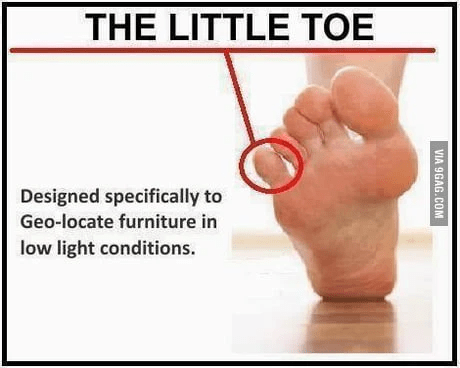 https://m.9gag.com/gag/awxZ5M8/even-the-little-toe-has-a-purpose
https://m.9gag.com/gag/awxZ5M8/even-the-little-toe-has-a-purpose
The second, third or fourth toe nails are often thick when that toe is hammered or clawed.
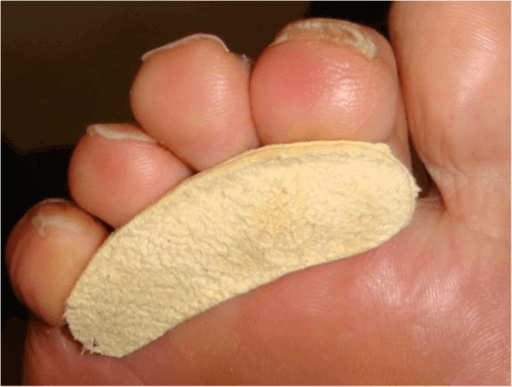
Thick second toenail of a clawed toe
Disease States and Medical Conditions That Can Cause Thickened Toenails
The two most common diseases that cause toenail thickening (and discolouring) include:
- Fungal infection (onychomycosis)
- Psoriasis
Non-diseased thickened toenails may have a slightly more yellow colour. Fungal and psoriatic nails look different. They may show one or more of the following:
- Yellow or brown discolouration
- Crumbling, chalky, brittle, split or scaly appearance
- Longitudinal streaks running from tip to base (not side to side)
- The nail may be elevated from the nail bed
- This makes it easy for dirt and debris to accumulate under the nail
- A bad odour
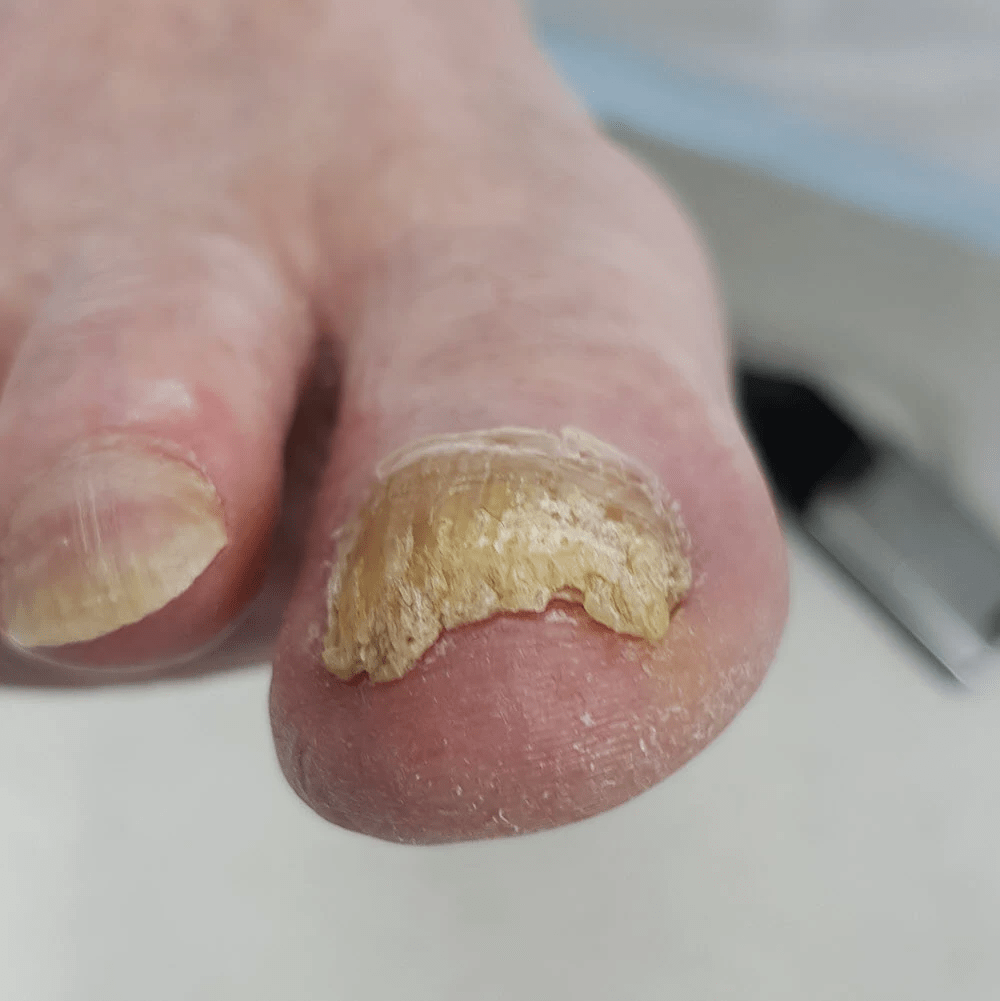
Thick yellow toenail with a rough free edge due to a fungal infection
Thick Toenail Treatment
When caused by trauma, toenail thickening is a permanent change. Most nail scissors or clippers won't be able to get through them. We stock a great pair of toenail clippers that are super-sharp and extremely easy to use with their thick contoured handles (video below).
If you’re having trouble with this, see a podiatrist. We use a “drill” that painlessly grinds and thins the nail very quickly. Or if your toenails are thick due to a fungal infection or psoriasis, these conditions can be treated. It would be wise to consult your podiatrist, doctor or dermatologist to find out how best to achieve this.
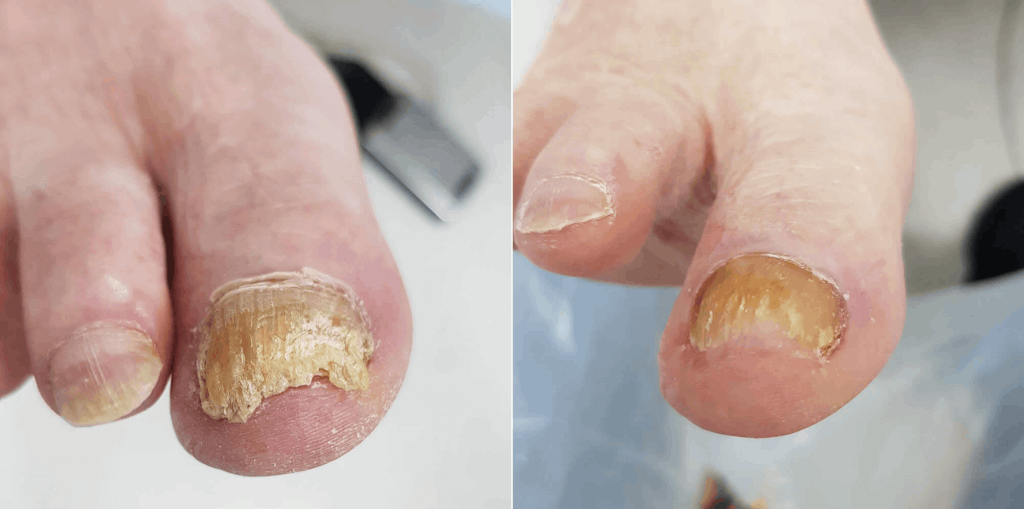
Thick fungal toenail before and after podiatry treatment
John Vonhof frequently discusses the long, thick and rough toenails he sees lead to toenail blisters at ultramarathons. He explains how the rough free edge catches the sock. Watch the video below and copy this technique to keep your nail’s free edge nice and smooth so it won’t catch on your sock.
Summing Up
- Thick toenails are difficult to trim, sometimes unsightly, but otherwise not painful.
- While there are disease states that can cause the thickening, many times, toenails get thick following a single traumatic insult, or repetitive microtrauma.
- Thickening will take at least 3 months to show after trauma, and it will be a permanent change.
- Thick toenails predispose to blisters under the toenail. To reduce your risk, keep your toenail as thin and smooth at the edge as you can, with the help of a podiatrist if necessary.


